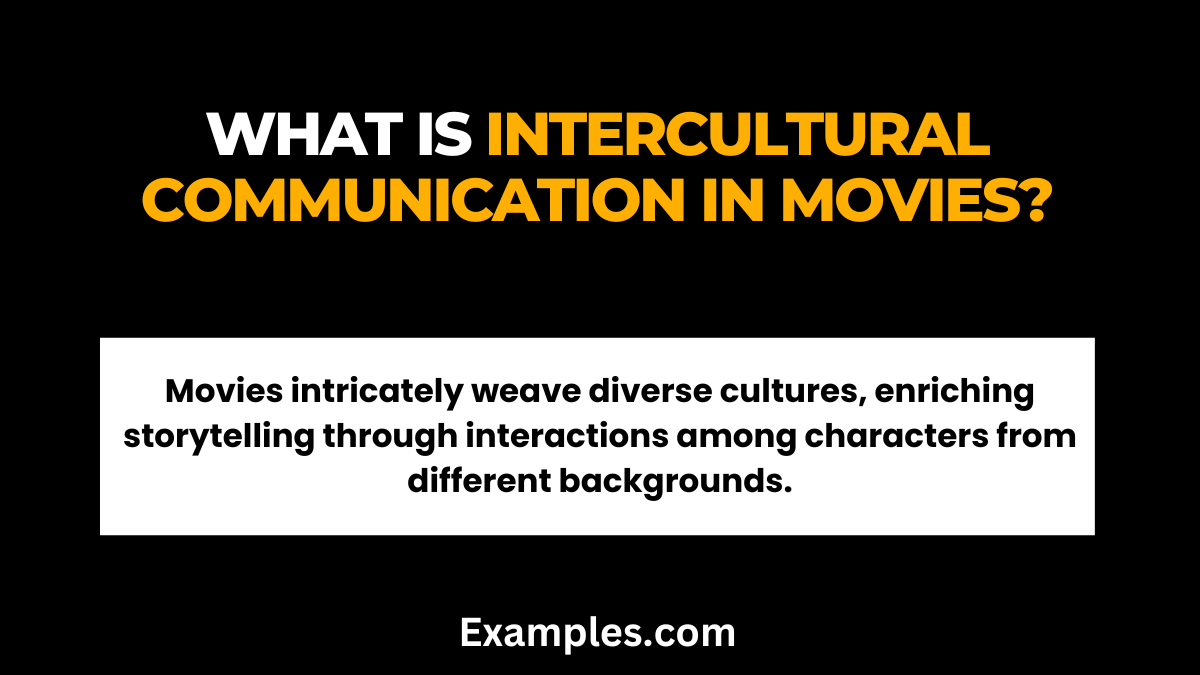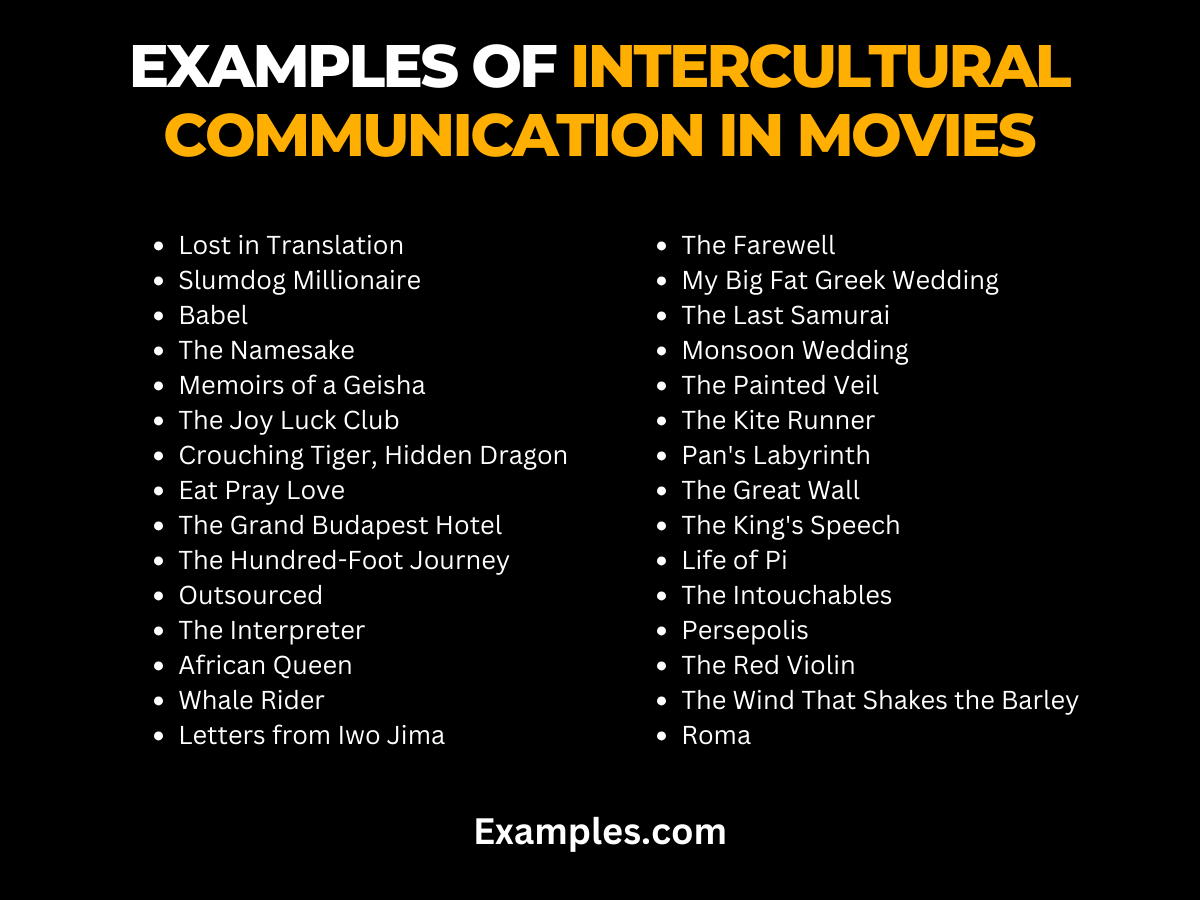Intercultural Communication in Movies
Embark on a cinematic journey with our “Intercultural Communication in Movies” guide. Delve into rich examples that illuminate the nuances of cross-cultural interactions on the silver screen. Uncover insights and practical tips to enhance your communication skills, all while enjoying the diverse narratives portrayed in film. This comprehensive guide is your key to understanding and applying effective intercultural communication, with real-world Communication Examples woven throughout for a truly immersive learning experience.
What is Intercultural Communication in Movies?

Intercultural Communication in Movies refers to the portrayal and exchange of diverse cultural perspectives within cinematic storytelling. This concept underscores how films become powerful mediums to showcase interactions, conflicts, and collaborations between characters from different cultural backgrounds. It involves the depiction of cultural nuances, values, and communication styles, offering audiences a nuanced understanding of the complexities that arise in cross-cultural encounters. Through the lens of cinema, Intercultural Communication in Movies enriches storytelling by weaving cultural diversity into the fabric of narratives.
What is the best example of Intercultural Communication in Movies?

One exceptional illustration of Intercultural Communication in Movies is evident in the film “Lost in Translation.” Directed by Sofia Coppola, the narrative unfolds in Tokyo, featuring two protagonists from different cultural backgrounds – Bob, an American actor, and Charlotte, a young woman visiting with her photographer husband. As they navigate the complexities of the unfamiliar Japanese culture, the film artfully captures the nuances of communication, highlighting cultural misunderstandings, shared moments of connection, and the universal desire for understanding. This cinematic masterpiece serves as a poignant exploration of the beauty and challenges inherent in cross-cultural interactions, leaving a lasting impact on viewers.
30 Examples of Intercultural Communication in Movies

- Lost in Translation: Explores cultural nuances in Tokyo, showcasing the complexities of cross-cultural communication.
- Slumdog Millionaire: Unravels the intricacies of Indian society, offering a glimpse into its diverse cultural landscape.
- Babel: Spans multiple countries, highlighting the challenges and beauty of cross-cultural interactions.
- The Namesake: Explores cross-cultural romance and the dynamics of identity in a global context.
- Memoirs of a Geisha: Provides insights into the world of traditional Japanese culture and communication.
- The Joy Luck Club: Depicts the cultural clash and connection between Chinese-American mothers and daughters.
- Crouching Tiger, Hidden Dragon: Melds martial arts with Chinese cultural elements, offering a visual feast.
- Eat Pray Love: Explores self-discovery through travels across Italy, India, and Indonesia, emphasizing cultural experiences.
- The Grand Budapest Hotel: Blends comedy with a multilayered narrative set in a fictional European location.
- The Hundred-Foot Journey: Delves into the clash and fusion of Indian and French culinary cultures.
- Outsourced: Explores the challenges of cultural adaptation when a call center is outsourced to India.
- The Interpreter: Unravels political intrigue and cultural complexities at the United Nations.
- African Queen: Captures cultural clashes during an adventurous journey in Africa.
- Whale Rider: Explores Maori culture and the struggle for tradition in contemporary New Zealand.
- Letters from Iwo Jima: Offers a perspective on World War II from the Japanese side, delving into cultural contexts.
- The Farewell: Navigates the interplay of Chinese and American cultures in the context of family and traditions.
- My Big Fat Greek Wedding: Chronicles the clash of cultures in a Greek-American family.
- The Last Samurai: Examines cultural clashes in feudal Japan through the eyes of a Westerner.
- Monsoon Wedding: Showcases the vibrant and intricate traditions of an Indian wedding.
- The Painted Veil: Unravels cultural complexities in colonial-era China, exploring love and redemption.
- The Kite Runner: Explores the cultural landscape of Afghanistan, weaving a tale of friendship and redemption.
- Pan’s Labyrinth: Blends Spanish history with dark fantasy, providing a unique cultural narrative.
- The Great Wall: Merges historical fiction with Chinese mythology and culture.
- The King’s Speech: Delves into British royal culture and the challenges of communication.
- Life of Pi: Weaves a visually stunning narrative that explores cultural and spiritual dimensions.
- The Intouchables: Explores the unlikely friendship between a quadriplegic aristocrat and his caregiver from the French suburbs.
- Persepolis: Offers a glimpse into Iranian culture and history through a graphic novel adaptation.
- The Red Violin: Spans centuries and cultures, following the journey of a violin through different hands.
- The Wind That Shakes the Barley: Explores cultural and political tensions in Ireland during the War of Independence.
- Roma: Provides a poignant portrayal of 1970s Mexico, capturing the nuances of domestic and societal dynamics.
What are the movies in intercultural communication?
1.”Lost in Translation” (2003)
- Setting: Tokyo, Japan
- Synopsis: Explores the nuanced connection between two characters amidst cultural disorientation, emphasizing the impact of language barriers.
2. “The Constant Gardener” (2005)
- Setting: Kenya and the UK
- Synopsis: Unveils the complexities of international pharmaceutical practices, highlighting the clash between Western and African cultures during a health crisis.
3. “The Interpreter” (2005)
- Setting: United Nations, New York
- Synopsis: Revolves around a UN interpreter caught in a political conspiracy, showcasing the challenges of communication in a multicultural diplomatic setting.
4. “Babel” (2006)
- Settings: Morocco, Japan, Mexico, and the United States
- Synopsis: Weaves together multiple narratives, revealing the ripple effect of miscommunication and cultural differences across different continents.
5. “Hotel Rwanda” (2004)
- Setting: Rwanda
- Synopsis: Depicts the harrowing events of the Rwandan genocide, emphasizing the role of communication in crisis situations and international intervention.
6. “The Hundred-Foot Journey” (2014)
- Setting: France and India
- Synopsis: Illustrates cultural clashes and eventual harmony through the story of an Indian family opening a restaurant in France.
7. “Crash” (2004)
- Setting: Los Angeles, USA
- Synopsis: Explores racial and cultural tensions in a multicultural city, demonstrating how misunderstandings can escalate into crises.
8. “Children of Men” (2006)
- Setting: United Kingdom
- Synopsis: Unfolds in a dystopian world facing infertility, where diverse cultures struggle to coexist, showcasing the impact of societal crises on intercultural dynamics.
Importance of Intercultural Communication in Movies?
1.Global Storytelling Dynamics
- Enhanced Narratives: Intercultural communication adds richness and authenticity to storytelling, broadening the scope for diverse and globally resonant plots.
2. Cultural Sensitivity Awareness
- Audience Sensitization: Movies facilitate cultural understanding by portraying diverse perspectives, fostering awareness, and minimizing stereotypes.
3. Realism in Character Development
- Authentic Characters: Intercultural communication allows for the creation of authentic characters whose backgrounds and interactions reflect the complexity of real-world cultural dynamics.
4. Reflecting Global Challenges
- Crisis Portrayal: Movies depict crises and conflicts with intercultural dimensions, offering insights into the challenges of navigating cultural differences during pivotal moments.
5. Cross-Cultural Relationship Exploration
- Romantic and Social Dynamics: Intercultural communication in movies delves into the complexities of cross-cultural relationships, exploring the intricacies of love, friendship, and collaboration.
6. Cultural Commentary and Critique
- Societal Reflection: Films serve as a mirror to societal norms and values, enabling commentary and critique on cultural issues, sparking discussions on a global scale.
7. Global Box Office Appeal
- Diverse Audience Attraction: Movies with strong intercultural communication themes appeal to a global audience, transcending cultural boundaries and maximizing box office potential.
8. Promoting Cultural Unity
- Harmony and Understanding: Intercultural communication in movies fosters a sense of unity and understanding, emphasizing the shared human experience despite cultural differences.
How to improve intercultural communication in Movies?
1.In-Depth Cultural Research
- Thorough Background Study: Conduct extensive research on the cultural nuances and norms relevant to the movie’s setting, ensuring accurate representation and minimizing stereotypes.
2. Consultation with Cultural Experts
- Collaboration with Advisors: Engage cultural experts or consultants from the depicted cultures to provide insights, guidance, and feedback throughout the filmmaking process.
3. Diverse Writing and Directing Teams
- Inclusive Creativity: Promote diversity in the writing and directing teams to bring varied perspectives, fostering authenticity and avoiding cultural misrepresentations.
4. Language Authenticity
- Linguistic Accuracy: Ensure accurate portrayal of languages spoken, including dialects, accents, and idioms, to capture the authentic linguistic diversity of the depicted cultures.
5. Cultural Sensitivity Training for Cast
- Preparation for Authentic Performance: Provide cultural sensitivity training for actors to understand and embody the behaviors, gestures, and communication styles authentic to their characters.
6. Collaborative Story Development
- Inclusive Storytelling: Encourage collaboration among writers, directors, and actors from different cultural backgrounds to contribute to the narrative, ensuring a more inclusive and accurate representation.
7. Pre-Release Cultural Screenings
- Audience Feedback:* Conduct pre-release screenings with diverse audience groups to gather feedback on cultural authenticity, addressing potential concerns before the official release.
8. Promotion of Intercultural Dialogue
- Post-Release Discussions: Facilitate post-release discussions and interviews that focus on the movie’s intercultural elements, promoting dialogue and understanding among audiences.



